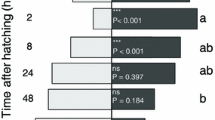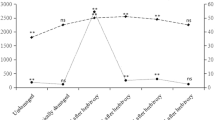Abstract
Stimuli from the plant Camellia japonica that influence the host-finding and acceptance behaviors of adult females of the generalist herbivore Epiphyas postvittana were investigated. In a binary choice test in a small (35-cm-diam.) arena, females discriminated between a plant and a laminated card model, laying many more eggs on the plant. Observations of females showed that the greater number of eggs laid on the plant were primarily due to on-plant behaviors, with females spending significantly more time per visit on the plant than on the model. Interestingly, females landed a similar number of times on the plant as on the model, suggesting that volatile chemicals from the plant did not influence host-finding. This observation was further supported by wind-tunnel studies, in which females showed little or no upwind flight activity in response to plants and laid similar numbers of eggs on upwind and downwind plants. Leaf surface texture, a combination of smoothness and fine structure (consisting of the midvein and other raised leaf veins), was found to stimulate egg laying by females. Methanol, dichloromethane, and pentane extracts were made of the waxes on the leaf surface. Of these three extracts, only the nonpolar (pentane) one stimulated egg laying by females. Although we did not find a role for volatile plant chemicals in host finding, they appeared to stimulate increased egg laying when the female was on the plant. It appears likely that these chemical and tactile stimuli in C. japonica are general stimuli, which may be found in a large number of plants and, in combination with the feeding preferences of the larva, may explain the generalist herbivorous nature of this pest.
Similar content being viewed by others

REFERENCES
Breeden, D. C., Young, T. E., Coates, R. M., and Juvik, J. A. 1996. Identification and bioassay of kairomones for Helicoverpa zea. J. Chem. Ecol. 22:513–539.
Chew, F. S., and Robbins, R. K. 1984. Egg-laying in butterflies. Symp. R. Entomol. Soc. London 11:65–79.
Danthanarayana, W. 1975. The bionomics, distribution and host range of the lightbrown apply moth, Epiphyas postivittana (Walk.) Tortricidae. Aust. J. Zool. 23:419–437.
Degen, T., and Stadler, E. 1997. Foliar form, colour and surface characteristics influence oviposition behaviour of the carrot fly. Entomol. Exp. Appl. 83:99–112.
Eigenbrode, S. D., and Espelie, K. E. 1995. Effects of plant epicuticular lipids on insect herbivores. Annu. Rev. Entomol. 40:171–194.
Fein, B. L., Reissig, W. H., and Roelofs, W. L. 1982. Identification of apple volatiles attractive to the apple maggot, Rhagoletis pomonella. J. Chem. Ecol. 8:1473–1487.
Foster, S. P., and Harris, M. O. 1992. Foliar chemicals of wheat and related grasses influencing oviposition by the Hessian fly, Mayetiola destructor (Say) (Cecidomyiidae). J. Chem. Ecol. 18:1965–1980.
Foster, S. P., and Harris, M. O. 1997. Behavioral manipulation methods for insect pest management. Annu. Rev. Entomol. 42:123–147.
Foster, S. P., Howard, A. J., and Harris, M. O. 1997. The influence of tactile and other nonchemical factors on the ovipositional responses of the generalist herbivore Epiphyas postvittana. Entomol. Exp. Appl. 83:147–159.
Guerin, P. M., StÄdler, E., and Buser, H. R. 1983. Identification of host plant attractants for the carrot fly, Psila rosae. J. Chem. Ecol. 9:843–861.
Harris, M. O., and Foster, S. P. 1995. Behavior and integration, pp. 3–46, in R. T. Cardé and W. J. Bell (eds.). Chemical Ecology of Insects 2. Chapman and Hall, New York.
Harris, M. O., and Miller, J. R. 1988. Host-acceptance behaviour in an herbivorous fly, Delia antiqua. J. Insect Physiol. 34:179–190.
Harris, M. O., and Rose, S. 1990. Chemical, color, and tactile cues influencing oviposition behavior of the Hessian fly (Diptera: Cecidomyiidae). Environ. Entomol. 19:303–308.
Haynes, K. F., and Baker, T. C. 1989. An analysis of anemotactic flight in female moths stimulated by host odour and comparison with the males' response to sex pheromone. Physiol. Entomol. 14:279–289.
Honda, K. 1995. Chemical basis of differential oviposition by lepidopterous insects. Arch. Insect Biochem. Physiol. 30:1–23.
JMP. 1991. JMP. 2.05. SAS Institute, Inc., Cary, North Carolina.
Judd, G. J. R., and Borden, J. H. 1989. Distant olfactory response of the onion fly, Delia antiqua, to host-plant odour in the field. Physiol. Entomol. 14:429–441.
Landolt, P. J. 1989. Attraction of the cabbage looper to host plants and host plant odor in the laboratory. Entomol. Exp. Appl. 53:117–124.
Lecomte, E., and Thibout, E. 1981. Attraction d'Acrolepiopsis assectella, en olfactometre par des substances allelochimiques volatiles d'Allium porrum. Entomol. Exp. Appl. 30:293–300.
Miller, J. R., and Roelofs, W. L. 1978. Sustained-flight tunnel for measuring insect responses to wind-borne sex pheromones. J. Chem. Ecol. 4:187–198.
Miller, J. R., and Strickler, K. L. 1984. Finding and accepting host plants, pp. 127–157, in W. J. Bell and R. T. Cardé (eds.). Chemical Ecology of Insects. Chapman and Hall Ltd, London.
Ramaswamy, S. B. 1988. Host finding by moths: Sensory modalities and behaviours. J. Insect Physiol. 34:235–249.
Ramaswamy, S. B., Ma, W. K., and Baker, G. T. 1987. Sensory cues and receptors for oviposition by Heliothis virescens. Entomol. Exp. Appl. 43:159–168.
Renwick, J. A. A. 1983. Nonpreference mechanisms: Plant characteristics influencing insect behavior, pp. 199–213, in P. A. Hedin (Ed.). Plant Resistance to Insects. American Chemical Society, Washington, D.C.
Renwick, J. A. A. 1989. Chemical ecology of oviposition in phytophagous insects. Experientia 45:223–228.
Renwick, J. A. A., and Chew, F. S. 1994. Oviposition behavior in Lepidoptera. Annu. Rev. Entomol. 39:377–400.
Roessingh, P., and StÄdler, E. 1990. Foliar form, colour and surface characteristics influence oviposition behaviour in the cabbage root fly Delia radicum. Entomol. Exp. Appl. 57:93–100.
Singh, P. 1974. A chemically-defined medium for rearing Epiphyas postvittana (Lepidoptera: Torticidae). N.Z. J. Zool. 1:241–243.
Spencer, J. L. 1996. Waxes enhance Plutella xylostella oviposition in response to singrin and cabbage homogenates. Entomol. Exp. Appl. 81:165–173.
StÄdler, E. 1984. Contact Chemoreception, pp. 3–35, in W. J. Bell and R. T. Cardé (eds.). Chemical Ecology of Insects. Chapman and Hall, London.
Suckling, D. M., Karg, G., Gibb, A. R., and Bradley, S. J. 1996. Electroantennogram and oviposition responses of Epiphyas postvittana (Lepidoptera: Tortricidae). N.Z. J. Crop Hortic. Sci. 24:323–333.
Thorsteinson, A. J. 1960. Host selection in phytophagous insects. Annu. Rev. Entomol. 5:193–218.
Tingle, F. C., and Mitchell, E. R. 1991. Effect of oviposition deterrents from elderberry on behavioral responses by Heliothis virescens to host-plant volatiles in flight tunnel. J. Chem. Ecol. 17:1621–1631.
Tingle, F. C., Heath, R. R., and Mitchell, E. R. 1989. Flight responses of Heliothis subflexa (Gn.) females (Lepidoptera: Noctuidae) to an attractant from ground cherry, Physalis angulata. J. Chem. Ecol. 15:221–231.
Tomkins, A. R., Penman, D. R., and Chapman, R. B. 1991. Leafroller oviposition on larval host plants. N.Z. Entomol. 14:37–41.
Udayagiri, S., and Mason, C. E. 1995. Host plant constituents as oviposition stimulants for a generalist herbivore: European corn borer. Entomol. Exp. Appl. 76:59–65.
Udayagiri, S., and Mason, C. E. 1997. Epicuticular wax chemicals in Zea mays influence oviposition in Ostrinia nubilalis. J. Chem. Ecol. 23:1675–1687.
Visser, J. 1986. Host odor perception in phytophagous insects. Annu. Rev. Entomol. 31:121–144.
Wearing, C. H., Thomas, W. P., Dugdale, J. S., and Danthanarayana, W. 1991. Tortricid pests of pome and stone fruits, Australian and New Zealand species, pp. 453–472, in L. P. S. Van der Geest and H. H. Evenhuis (eds.). Tortricid Pests, Their Biology, Natural Enemies and Control. Elsevier, Amsterdam.
Author information
Authors and Affiliations
Rights and permissions
About this article
Cite this article
Foster, S.P., Howard, A.J. Influence of Stimuli from Camellia japonica on Ovipositional Behavior of Generalist Herbivore Epiphyas postvittana . J Chem Ecol 24, 1251–1275 (1998). https://doi.org/10.1023/A:1022455120922
Issue Date:
DOI: https://doi.org/10.1023/A:1022455120922



